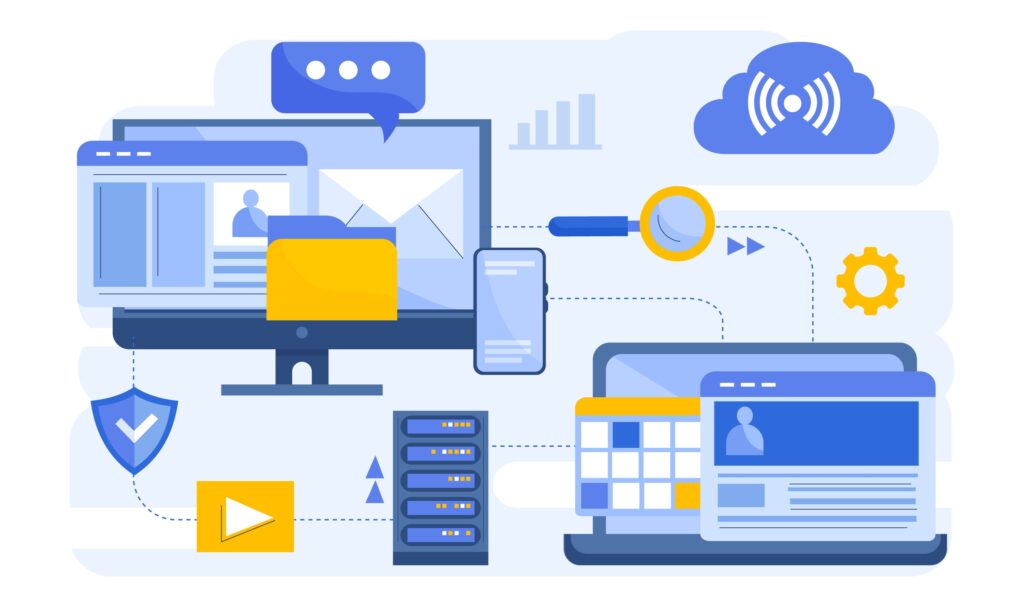SAP, which stands for Systems, Applications, and Products in Data Processing, is a global software company that specializes in creating enterprise resource planning (ERP) solutions. Founded in 1972 in Germany by five former IBM employees, SAP was established with the vision of revolutionizing business operations through integrated technology. Today, SAP is recognized as one of the world’s leading providers of business software, helping organizations across industries streamline processes, make data-driven decisions, and drive efficiency in various operational domains.
In this article, we’ll explore the evolution of SAP, its key components, and the significant benefits it offers to businesses worldwide.
A Brief History of SAP
SAP’s journey began in the early 1970s when five IBM engineers recognized a growing need for software that could integrate various business functions into a single platform. Their first product, SAP R/1, was a simple but powerful solution for financial accounting. As the company grew, so did its offerings. SAP R/2 followed, marking an important shift to larger, mainframe-based systems.
In the 1990s, the introduction of SAP R/3—the company’s first fully integrated ERP system—propelled SAP to the forefront of the software industry. It allowed businesses to streamline their processes across various functions like procurement, logistics, and human resources.
Fast-forward to 2010, and SAP revolutionized its offerings once again with the launch of SAP HANA, an in-memory database platform. This breakthrough technology made real-time analytics and data processing possible, allowing businesses to make faster, more informed decisions.
Today, SAP stands as a leader in the enterprise software market, with solutions used by thousands of organizations around the globe. Its evolution continues with SAP S/4HANA, an advanced version of its ERP suite designed for the digital economy.
What is SAP Software Used For?
SAP software is a comprehensive solution designed to manage and integrate various business processes within an organization. Additionally, it enhances customer interactions and service delivery, optimizes supply chain operations, and supports effective human resource management. Overall, SAP software facilitates integrated business management, driving operational efficiency and supporting organizational growth. Businesses of all sizes use SAP to handle core activities such as:
- Finance & Accounting: SAP provides tools for managing financial transactions, reporting, and auditing, helping businesses keep track of their financial health.
- Human Resources: SAP’s HR solutions streamline employee management, from payroll and recruitment to performance tracking and training.
- Supply Chain Management: SAP optimizes logistics, procurement, inventory management, and production planning to improve efficiency and reduce costs.
- Customer Relationship Management: SAP enhances customer service by providing tools to manage sales, marketing, and customer interactions.
- Analytics & Reporting: With SAP’s advanced analytics tools, businesses can gain valuable insights into their operations and market trends.
By unifying these functions under a single platform, SAP software helps businesses improve coordination, reduce redundancy, and increase overall productivity.
Critical Components of SAP Software
SAP offers a comprehensive suite of software solutions designed to address diverse business needs across various sectors. Here are some of the essential components and solutions within the SAP ecosystem:
SAP ERP
At the heart of SAP’s offerings is its ERP (Enterprise Resource Planning) software, which integrates multiple business functions into a unified platform. SAP ERP encompasses critical areas such as financial accounting, human resources, procurement, and logistics. By centralizing data and processes, SAP ERP facilitates streamlined management and enhances operational efficiency across the organization.
SAP S/4HANA
Building on the foundation of SAP ERP, SAP S/4HANA represents a significant advancement in SAP’s software solutions. This next-generation ERP suite is powered by the SAP HANA in-memory database, providing real-time analytics and a more streamlined data model. SAP S/4HANA offers a modern user experience with improved performance and capabilities, making it an ideal choice for businesses seeking innovative solutions.
SAP Business Intelligence (BI)
SAP’s Business Intelligence solutions enable organizations to transform data into actionable insights. With tools such as SAP BusinessObjects, SAP Lumira, and SAP Analytics Cloud, businesses can gather, analyze, and visualize data to support informed decision-making. These BI tools help organizations uncover trends, optimize processes, and drive strategic initiatives.
SAP Customer Relationship Management (CRM)
SAP’s CRM solutions are designed to enhance customer interactions and drive growth. They support a range of functions, including sales, marketing, and customer service. By improving customer engagement and relationship management, CRM helps businesses deliver exceptional experiences and build long-term customer loyalty.
SAP Supply Chain Management (SCM)
The SAP SCM suite assists organizations in optimizing their supply chain operations. It covers various aspects from demand planning and procurement to production and logistics management. By improving supply chain efficiency, SAP SCM helps businesses reduce costs and improve service levels.
SAP Human Capital Management (HCM)
SAP HCM provides a comprehensive approach to managing human resources. It includes functionalities for payroll, talent management, and workforce planning. SAP HCM supports organizations in attracting, developing, and retaining talent, which is critical for driving organizational success.
SAP Industry Solutions
SAP offers specialized solutions tailored to specific industries, such as retail, manufacturing, healthcare, and utilities. These industry-specific solutions address unique challenges and compliance requirements, providing targeted support and functionality.
SAP Cloud Platform
The SAP Cloud Platform serves as a versatile foundation for developing and deploying applications. It supports the integration and extension of existing SAP solutions, fostering innovation, scalability, and flexibility in the cloud.
These components collectively represent SAP’s extensive capabilities in supporting various business functions and industries, driving efficiency and growth through integrated and innovative solutions.
Functions of SAP Software
SAP software encompasses several core functions that help organizations run their day-to-day operations smoothly. Some of these primary functions include:
- Integrated Data Management: SAP centralizes data across various departments, ensuring a single source of truth and reducing the risk of errors and inconsistencies. This integration is crucial for making accurate, data-driven decisions.
- Automation of Business Processes: SAP automates many repetitive tasks, such as data entry, financial reporting, and supply chain logistics. Automation reduces manual workload, boosts productivity, and minimizes errors.
- Real-Time Analytics and Reporting: With SAP’s in-memory computing capabilities, businesses can analyze data in real time. This enables faster, more informed decision-making across all levels of the organization.
- Collaboration and Communication: SAP enables cross-functional collaboration by providing a platform where different departments—such as finance, HR, and sales—can access and share relevant data. This improves coordination and enhances business performance.
- Customization and Scalability: SAP software is highly customizable, allowing businesses to tailor solutions to meet their specific needs. Additionally, its scalable architecture supports growth, whether an organization is expanding in size or complexity.
Benefits of SAP Software
SAP software offers a range of benefits that help businesses increase efficiency, enhance decision-making, and support growth. Here are some of the key advantages of implementing SAP:
1. Enhanced Efficiency
SAP streamlines business processes by automating routine tasks and centralizing operations. This reduces manual effort, minimizes errors, and accelerates workflows, allowing employees to focus on more strategic tasks.
2. Real-Time Data Insights
SAP’s in-memory computing technology enables real-time data processing, which is crucial for businesses that need to make quick decisions. With instant access to up-to-date information, companies can respond to changing market conditions, optimize processes, and gain a competitive edge.
3. Improved Customer Experience
SAP’s CRM solutions allow businesses to engage with customers in a more personalized way, leading to better service, higher satisfaction, and long-term customer loyalty. By leveraging data, businesses can predict customer needs and provide tailored solutions.
4. Cost Control
With SAP’s ability to optimize processes and reduce inefficiencies, companies can lower operational costs. Its comprehensive resource management tools ensure that businesses allocate their resources effectively, leading to better cost control and improved profit margins.
5. Scalability
SAP software is designed to grow with businesses. Whether a small company or a global enterprise, SAP’s solutions are flexible and scalable, making it easy to adapt to new challenges and expand as needed.
6. Compliance and Security
SAP’s solutions provide robust security features and help businesses meet regulatory requirements. From data encryption to compliance tracking, SAP ensures that sensitive information is protected and businesses remain compliant with industry standards.
Uses of SAP Software
SAP software serves a multitude of purposes, offering various applications that meet the needs of businesses across different industries. Some of the key uses of SAP software include:
- Enterprise Resource Planning (ERP): SAP helps integrate critical business functions like finance, human resources, procurement, and supply chain management into one system, ensuring data consistency and seamless workflows.
- Supply Chain and Logistics Management: Businesses use SAP to optimize their supply chains by improving procurement, inventory management, production planning, and distribution processes.
- Customer Relationship Management (CRM): SAP provides tools for managing and enhancing customer interactions across sales, marketing, and service, helping businesses improve customer satisfaction and loyalty.
- Financial Management and Reporting: SAP’s financial modules help organizations with managing accounts, reporting, auditing, and compliance. This allows businesses to streamline their financial operations and make strategic decisions based on real-time financial data.
- Human Capital Management (HCM): SAP aids in workforce management, covering areas like recruitment, performance management, payroll, and employee development. This helps businesses build and maintain a strong workforce.
- Business Intelligence and Analytics: SAP enables companies to analyze large amounts of data, providing actionable insights for better decision-making, planning, and strategy development.
- By leveraging these applications, SAP empowers businesses to operate more efficiently, improve decision-making, and maintain a competitive edge.
Impact of SAP Software on Businesses
The implementation of SAP offers transformative benefits for businesses across various sectors and sizes. Its robust suite of tools and solutions provides a range of advantages that enhance organizational performance and strategic capabilities:
Efficiency and Productivity
SAP software significantly improves operational efficiency by automating routine tasks and streamlining business processes. By reducing manual intervention, SAP minimizes errors and accelerates workflows. This automation not only speeds up day-to-day operations but also frees up valuable time for employees to focus on higher-value activities, thereby boosting overall productivity.
Real-time Insights
One of SAP’s standout features is its use of in-memory computing technology. This capability allows businesses to access and analyze data in real-time, which is crucial for rapid decision-making and agile planning. With real-time insights, companies can respond more swiftly to market changes, identify trends, and make informed decisions based on the latest information.
Improved Customer Experiences
SAP’s Customer Relationship Management (CRM) solutions are designed to enhance how businesses interact with their customers. These tools enable organizations to deliver more personalized and responsive service, improving customer satisfaction and loyalty. By leveraging customer data effectively, businesses can tailor their interactions and offerings to meet individual needs, fostering stronger customer relationships.
Cost Control
SAP contributes to significant cost savings by optimizing processes and better-allocating resources. Through improved efficiency and reduced operational redundancies, organizations can lower their expenses and maximize the return on investment. The ability to streamline operations and manage resources effectively leads to a more cost-efficient business model.
Scalability
Scalability is a key advantage of SAP solutions. Whether a small business aiming to expand or a large enterprise managing intricate operations, SAP software can grow with the organization. Its flexible architecture supports the evolving needs of businesses, allowing them to scale their operations seamlessly and adapt to changing demands.
Compliance and Security
Maintaining compliance with regulatory requirements and ensuring data security is critical for any organization. SAP provides comprehensive tools to help businesses meet legal and industry standards while safeguarding sensitive information. With built-in security features and compliance management, SAP helps protect data integrity and support regulatory adherence.
Hence, SAP software delivers substantial benefits by enhancing efficiency, providing real-time insights, improving customer experiences, controlling costs, offering scalability, and ensuring compliance and security. These advantages collectively drive better business outcomes and support organizational growth and resilience.
SAP Software in the Cloud
Cloud computing has become an essential element for businesses looking for flexibility, scalability, and reduced infrastructure costs. SAP’s cloud-based offerings, such as SAP S/4HANA Cloud, SAP Business ByDesign, and SAP SuccessFactors, allow companies to run their business operations in a secure, scalable, and cost-effective cloud environment. Some key advantages of using SAP in the cloud include:
- Flexibility: Cloud-based SAP solutions are highly flexible, allowing businesses to scale up or down based on their needs. This makes it ideal for companies that require agility in today’s fast-paced business environment.
- Cost Savings: By moving to the cloud, businesses can significantly reduce infrastructure and maintenance costs. Cloud solutions also reduce the need for in-house IT management, freeing up resources for strategic initiatives.
- Global Access: SAP in the cloud enables access from anywhere, anytime, which is especially useful for companies with a distributed workforce or global operations. Cloud solutions also support collaboration and real-time data sharing across locations.
- Enhanced Security: SAP’s cloud offerings come with robust security features, including encryption, secure access controls, and regular updates to keep data protected.
By leveraging SAP’s cloud capabilities, businesses can enjoy benefits from cloud ERP, a cutting-edge technology without the complexity and costs associated with managing on-premise solutions.
Conclusion
SAP has fundamentally changed the way businesses operate by providing a powerful suite of integrated solutions that enhance efficiency, productivity, and decision-making. From its humble beginnings in the 1970s to its current position as a global leader in enterprise software, SAP has continued to innovate and evolve. Today, its suite of ERP solutions, advanced analytics tools, and industry-specific applications play a critical role in helping businesses navigate an increasingly complex digital landscape. By embracing SAP, organizations can streamline operations, make smarter decisions, and ensure long-term growth and success.





